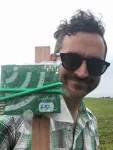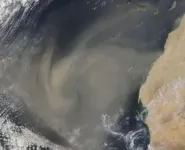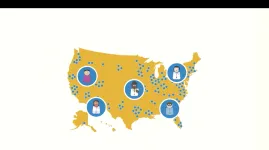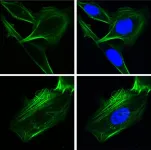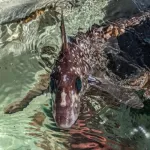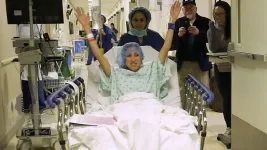(Press-News.org) New research led by Adam Dixon, a conservation scientist with the World Wildlife Fund, describes the successful pilot of a novel method to study how well grassland birds are faring on croplands. The study, published in Ecological Applications, looked at 44 pockets of non-crop vegetation in the gaps between crop rows and at the edges of fields on lands under intensive agricultural cultivation in Iowa. The study may serve as a model for monitoring wildlife on working lands more generally, which can include crop fields, cattle ranches, and logged forests.
The researchers analyzed satellite imagery data to determine each pocket's area and “texture,” referring to the variety in plant species, height, and density in the habitat. Simple, inexpensive on-site bioacoustic recorders—essentially circuit boards with a battery and mini cell phone microphone attached, all sealed in a plastic bag—helped the team identify which bird species were using the habitat. Both methods were low-cost and required very few visits to the lands under study, demonstrating the scalability of this approach.
The combination of techniques allowed the researchers to determine that larger habitat area and greater variety in texture were associated with more bird species overall. However, the results also revealed that species reliant on grassland habitat for their entire life cycle (mating, raising young, foraging, etc.) seemed to benefit less than birds who only used the habitat for certain activities, such as hunting.
“Using novel methods, we found that agricultural habitats are good for birds in general, but when you look at grassland birds specifically, either there’s not enough habitat or the habitat characteristics aren’t good,” Dixon says, who studies working lands biodiversity in the northern U.S. plains for the World Wildlife Fund.
The study’s relatively small sample size limited the researchers’ ability to determine whether habitat texture and area each had independent effects on the birds. Still, the study showed that their unique method combining satellite imagery and bioacoustic data can help researchers effectively measure habitat quality and bird biodiversity. The authors hope their work encourages future studies incorporating more study sites to strengthen the statistical power of the results.
Beyond protected areas
Dixon grew up surrounded by large wheat farms in the Midwest and observed their effects on the environment, which informed his career goals. His formative experiences, he says, led to an understanding that protected areas alone are not enough to solve the biodiversity, food, and health challenges the U.S. and the world are facing. “I saw a lot of research emphasis on protected areas,” Dixon says, whereas he wanted to focus on the intersection of intensive agriculture and ecology.
Dixon completed the new research as part of his Ph.D. with Erle Ellis, a landscape ecologist at University of Maryland, Baltimore County whose work has focused for decades on the longstanding relationships between humans and landscapes across the planet. Ellis is senior author on the new paper.
“Agriculture covers more of this planet than protected areas do, and Adam’s research on bird habitats in Iowa farmlands confirms that even some of the most intensively managed agricultural landscapes on Earth can sustain significant biodiversity,” Ellis shares. “More research like Adam’s is needed to conserve, restore, and monitor biodiversity in the working landscapes needed to sustain both people and wildlife across more than three quarters of Earth’s land.”
Community collaboration
The new study is also unusual in that it took place on privately held farmland. Dixon worked with landowners to get permission to conduct research on their property, and in some cases farmers placed the recorders themselves.
“It’s difficult but not impossible to work on private lands,” Dixon says. “You just need to build trust and relationships.” In the future, Dixon would like to deepen his collaboration with farmers. Gathering more information about their management practices would open up additional research questions. Plus, learning about any barriers farmers face to participating in research could make it more likely that other projects requiring farmer buy-in would get off the ground.
“What was impressive about Adam’s investigation was his willingness to employ novel technology and ideas to overcome what has historically been an absolute challenge in surveying working landscapes,” says Matthew Baker, a UMBC ecologist and a co-author on the paper. “His example has really shown the potential and the need for additional study.”
Supporting farmers and the environment
Farmers lead a challenging existence, frequently operating on extremely thin financial margins and relying on fickle weather, Dixon says, which incentivizes them to simplify and control the landscape as much as possible. Unfortunately, that can lead to environmental harm. Through his work, Dixon wants to help find a middle way that supports both farmers and the environment. Many questions remain.
“How do we move from the necessity to simplify the system to something that’s more balanced and takes into account the entire environment? To something that understands the unique ecology of a place and integrates that into management, and allows the farmer to prosper across generations? How can we find a better solution besides just hoping that we’re going to protect these small patches?” Dixon asks.
Those questions are why Dixon has pursued research into biodiversity on working lands, he says. While the new paper may be a small step to better understanding how wildlife is and is not flourishing on working lands, it is a step in the right direction and opens the door for future projects.
“We need to integrate conservation solutions into our most intensive places,” Dixon says. “So this research identifies that as an area of valid research and also shows how that research might be done.”
END
Beyond protected areas: Novel method shows promise for monitoring biodiversity on working lands
Combo of bioacoustic recorders, satellite imagery shows how birds are faring on cropfields
2023-07-24
ELSE PRESS RELEASES FROM THIS DATE:
Is snacking bad for your health? It depends on what and when you eat
2023-07-24
Snacking is becoming increasingly popular, with more than 70% of people reporting they snack at least twice a day. In a new study involving more than 1,000 people, researchers examined whether snacking affects health and if the quality of snack foods matters.
“Our study showed that the quality of snacking is more important than the quantity or frequency of snacking, thus choosing high quality snacks over highly processed snacks is likely beneficial,” said Kate Bermingham, PhD, a postdoctoral fellow at King's College London. “Timing is also important, with late night snacking being unfavorable for health.”
Bermingham ...
One way to reduce medical errors? Connect doctors with other doctors
2023-07-24
We trust our doctors with our lives, but the sad and scary fact is that doctors can get things wrong. Approximately 100,000 Americans die each year due to medical errors and recent studies have found that 10 to 15% of all clinical decisions regarding patient diagnosis and treatment are wrong.
A team of researchers led by Damon Centola, Professor and Director of the Network Dynamics Group at the Annenberg School for Communication at the University of Pennsylvania, has found a simple, effective way to reduce errors in patient diagnosis and treatment — use structured networks to connect clinicians with other clinicians.
In a study published today in the journal ...
Study finds new, unexpected mechanism of cancer cell spread
2023-07-24
A surprising finding from USC reveals key details about how cancer cells metastasize and suggests new therapeutic approaches for halting their spread.
The research, supported by the National Institutes of Health, centers on a cellular chaperone protein known as GRP78, which helps regulate the folding of other proteins inside cells. Previous studies from the same team, led by Amy S. Lee, PhD, professor of biochemistry and molecular medicine at the Keck School of Medicine of USC, have shown that when cells are under stress (due to COVID-19 or cancer), GRP78 gets hijacked, allowing viral invaders to replicate, ...
Sahara dust can enhance removal of methane
2023-07-24
The study by Maarten van Herpen et al., entitled “Photocatalytic Chlorine Atom Production on Mineral Dust-Sea Spray Aerosols over North Atlantic,” was funded in part by the NGO Spark Climate Solutions. It incorporates a proposed new mechanism whereby blowing mineral dust mixes with sea-spray to form Mineral Dust-Sea Spray Aerosol (MDSA).
The results suggest that MDSA is activated by sunlight to produce an abundance of chlorine atoms, which oxidize atmospheric methane and tropospheric ozone via photocatalysis. Largely composed of blowing dust from the Sahara Desert combined with sea salt aerosol from the ocean, MDSA is the dominant source of atmospheric ...
Unlocking secrets of the elusive ghost shark
2023-07-24
Researchers from the University of Florida and the Seattle Aquarium are exploring 100 meters underwater in the Pacific Northwest this summer to learn more about mysterious ghost sharks, one of the strangest beasts from the depths of the ocean.
Using remotely operated underwater vehicles, or ROVs, the scientists searched for nesting grounds of the Pacific spotted ratfish, Hydrolagus colliei, a ghostlike fish that lurks on the ocean floor.
“We know very little about these elusive relatives of sharks and even less about their spawning habits and embryonic development,” said ...
Risk of fatal heart attack may double in heat wave & high fine particulate pollution days
2023-07-24
Research Highlights:
An analysis of more than 202,000 heart attack deaths between 2015-2020 in a single Chinese province found that days that had extreme heat, extreme cold or high levels of fine particulate matter (PM2.5) air pollution were significantly associated with the risk of death from a heart attack, especially in women and older adults.
The greatest increase in the risk of death from heart attack was seen on days that had the combination of extreme heat and high levels of PM2.5.
The days with extreme heat were associated ...
Study shows positive outcomes for first three U.S. living HIV-to-HIV kidney transplant donors
2023-07-24
Based on findings from a study published today in the journal, The Lancet Regional Health – Americas, researchers at Johns Hopkins Medicine and three collaborating medical institutions suggest that people living with the human immunodeficiency virus (HIV) who donate a kidney to other people living with HIV (PLWH) have a low risk of developing end-stage kidney disease (ESKD) or other kidney problems in the years following the donation.
“This new evidence is proof-of-concept that donating a kidney can be safe for people living with HIV,” says Christine Durand, M.D., associate professor of medicine at Johns ...
Webb detects water vapor in rocky planet-forming zone
2023-07-24
Water is essential for life as we know it. However, scientists debate how it reached the Earth and whether the same processes could seed rocky exoplanets orbiting distant stars. New insights may come from the planetary system PDS 70, located 370 light-years away. The star hosts both an inner disk and outer disk of gas and dust, separated by a 5 billion-mile-wide (8 billion kilometer) gap, and within that gap are two known gas-giant planets.
New measurements by NASA’s James Webb Space Telescope’s MIRI (Mid-Infrared Instrument) have detected water vapor in the system’s inner disk, at distances ...
Diagnosis of cystic fibrosis often missed or delayed, especially in non-White infants
2023-07-24
Ann & Robert H. Lurie Children’s Hospital of Chicago is leading an awareness campaign that aims to reduce missed or delayed diagnosis of cystic fibrosis after newborn screening, especially in non-White infants. In its first phase, the campaign targets primary care providers and public health officials, so that treatment can start earlier, which is linked to better outcomes for people with cystic fibrosis. The general public phase is expected to follow within the year.
Funded by the Centers for Disease Control and Prevention ...
Potent anti-cancer therapy created using ‘click chemistry’
2023-07-24
A potent anti-cancer therapy has been created using Nobel prize-winning “click chemistry”, where molecules click together like LEGO bricks, in a new study by UCL and Stanford University researchers.
The study, published in Nature Chemistry, opens up new possibilities for how cutting-edge cancer immunotherapies might be built in future.
The research team created an anti-cancer therapy with three components: one targeting the cancer cell, another recruiting a white blood cell called a T cell to attack the cancer cell, and a third knocking out part of the cancer cell’s defences.
Previously, ...
LAST 30 PRESS RELEASES:
Nitrogen is key to faster regrowth in deforested areas, say researchers
Recovering tropical forests grow back nearly twice as fast with nitrogen
A new diet option for mild-to-moderate Crohn’s disease
Electric vehicles could catch on in Africa sooner than expected
New test could help pinpoint IBD diagnosis, study finds
Common eye ointment can damage glaucoma implants, study warns
ACCESS-AD: a new European initiative to accelerate timely and equitable AD diagnosis, treatment and care
Mercury exposure in northern communities linked to eating waterfowl
New Zealand researchers identify brain link to high blood pressure
New research confirms people with ME/CFS have a consistent faulty cellular structure
Hidden cancer risk behind fatty liver disease targets
Born in brightness, leading to darkness
Boron-containing Z-type and bilayer benzoxene
Hong Kong researchers break the single-field barrier with dual-field assisted diamond cutting
Work hard, play hard?
Wood becomes smart glass: Photo- and electro-chromic membrane switches tint in seconds
The Lancet: COVID-19 vaccine hesitancy decreased over time, though mistrust persists among certain groups, study of over 1 million people in England suggests
Psychosis patients ‘living in metaphor’ -- new study radically shifts ideas about delusions
Clinical trial in Ethiopia targets the trachoma scourge
Open-sourcing the future of food
Changes in genetic structure of yeast lead to disease-causing genomic instabilities
UC San Diego Health Sciences Grant Writing Course helps launch successful research careers
Study: Many head and neck cancer trials end early. Why?
Tufts vice provost for research named Foreign Fellow of Indian National Science Academy
New model improves prediction of prostate cancer death risk
Two wrongs make a right: how two damaging variants can restore health
Overlooked decline in grazing livestock brings risks and opportunities
Using rare sugars to address alcoholism
Research alert: New vulnerability identified in aggressive breast cancer
Ruth Harris honored with SSA Distinguished Service Award
[Press-News.org] Beyond protected areas: Novel method shows promise for monitoring biodiversity on working landsCombo of bioacoustic recorders, satellite imagery shows how birds are faring on cropfields
